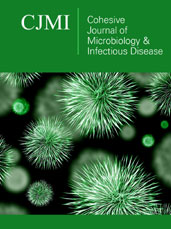- Submissions

Abstract
Cohesive Journal of Microbiology & Infectious Disease
Rare Case Study of Para-KDL with HIV Co-Infection and Their Treatment with Novel Combination Drugs Therapy Regimen
-
Open or CloseAnurag Pappu1, Major Madhukar1, Abhishek Kumar Rai2,3, Devendra Prasad
Yadav2, Vahab Ali2,3,4* and Krishna Pandey1*
1Department of Clinical Medicine, ICMR-Rajendra Memorial Research Institute of Medical Sciences, Agamkuan, Patna-800007, INDIA
2Laboratory of Molecular Biochemistry and Cell Biology, Department of Biochemistry, ICMR-Rajendra Memorial Research Institute of Medical Sciences, Agamkuan, Patna-800007, INDIA
3Department of Zoology, University of Calcutta, Senate House, Kolkata-700073
4Faculty of Biological Sciences, Academy of Scientific and Innovative Research (AcSIR), Sector-19, Kamla Nehru Nagar, Ghaziabad-201002, U.P, India
*Corresponding author: Krishna Pandey, Department of Clinical Medicine, ICMRRajendra Memorial Research Institute of Medical Sciences, Agamkuan, Patna-800007, India Vahab Ali, Laboratory of Molecular Biochemistry and Cell Biology, Department of Biochemistry, ICMR-Rajendra Memorial Research Institute of Medical Sciences, Agamkuan, Patna-800007, Faculty of Biological Sciences, Academy of Scientific and Innovative Research (AcSIR), Sector-19, Kamla Nehru Nagar, Ghaziabad-201002, U P and Department of Zoology, University of Calcutta, Senate House, Kolkata-700073, India
Submission: May 12, 2025;Published: June 03, 2025

ISSN: 2578-0190 Volume7 Issue4
Abstract
Visceral Leishmaniasis (VL), and Post Kala-Azar Dermal leishmaniasis (PKDL) are common problems in India, Nepal, Bangladesh, but both diseases can occur simultaneously sometime known as Para-Kala-Azar Dermal Leishmaniasis (Para-KDL). Similarly, HIV-VL co-infection is also common in Indian sub-continent. However, all three types of signs and symptoms occur rarely and have not yet been reported as per our knowledge. In September 2024 a rare case was diagnosed as VL-PKDL & HIV simultaneously in ICMRRMRIMS, Patna. The patient presented as fever with chills, loss of appetite, weakness and splenomegaly and mixed Nodulo-Papular lesions with positive LD bodies in the Splenic aspirates. Patient was also suffering from HIV-1 co-infection as confirmed by ELISA, low CD4+ level (176 cells/mm3) and HIV-RNA viral load (85 copies/ml). The patient was treated with six doses of Liposomal Amphotericin-B along with Miltefosine 50mg twice daily for 14 weeks. Follow-up studies after 5 months of treatment showed that patient was completely cured as signs and symptoms disappeared and he became healthy. Association of Para-KDL and HIV was noticed first time in Indian sub-continent and currently, no treatment guideline is available.
Keywords: Para-KDL; HIV; Liposomal amphotericin B resistance; Miltefosine
 a Creative Commons Attribution 4.0 International License. Based on a work at www.crimsonpublishers.com.
Best viewed in
a Creative Commons Attribution 4.0 International License. Based on a work at www.crimsonpublishers.com.
Best viewed in 







.jpg)






























 Editorial Board Registrations
Editorial Board Registrations Submit your Article
Submit your Article Refer a Friend
Refer a Friend Advertise With Us
Advertise With Us
.jpg)






.jpg)














.bmp)
.jpg)
.png)
.jpg)










.jpg)






.png)

.png)



.png)






